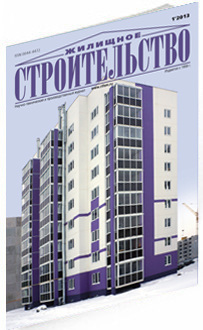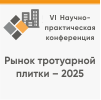Zhilishchnoe Stroitel'stvo №1

January, 2013
Table of contents
S.V. NIKOLAEV, Doctor of Technical Sciences, General Director, the Central Research and Design Institute for Residential and Public Buildings (Moscow)
It is shown that the mental attitude of the Russians to housing is changing under the influence of the socio-economic conditions. The growth of mobility of the active able-bodied part of the population, advance in living standard demand already at present to lay the future transformation potential into the designs of buildings under construction. Shortcomings of the main systems of housing construction are analyzed in terms of long preservation of consumer properties and a possibility of the radical rearrangement without the loss of bearing capacity of a building. It is concluded, that the system of panel-frame construction developed by TSNIIEPzhilishcha and including longitudinal bearing walls on which the long-length multi-core slabs of off-shuttering molding are based meets all prospective requirements. The SPDK ensures the matching of periods of obsolescence and physical wear of buildings at the level of 80-100 years.
Keywords: construction systems, large-panel housing construction, frame housing construction, monolithic housing construction, panel-frame housing construction system (SPDK), free arrangement of flats, long-term consumer properties, long-length multi-core floor slabs.
V.I. IL’ICHEV, Doctor of Technical Sciences, the First Vice-President of RAACS (Moscow); V.I. KOLCHUNOV, Doctor of Technical Sciences, Academician, RAACS; E.A. SKOBELEVA, Candidate of Technical Sciences, the State University - Education-Science-Production Complex (Orel)
Statistic data showing an increase in the number of disabled persons including the age group up to 18 years old in the total population of Russia are presented. An analysis of conceptual regulations of the normative requirements in force for designing the educational buildings accessible for disabled groups of population is presented from the position of biospheric compatibility. Some results of certification of such objects located on the territory of the Orlov oblast are shown.
Keyword: disabled persons, normative requirements, buildings of educational institutions, accessibility of buildings, biospheric-compatible urban environment.
V.S. LESOVIK, Corresponding Member of RAACS, Doctor of Technical Sciences, the Belgorod State Technological University named after V.G. Shukhov
Methodological approaches of the new perspective direction of GeoniCS – architectural GeonicCS – are considered. Examples of the realization of buildings of different purposes with the use of elements of architectural GeoniCS are presented. It is substantiated, that the development of this direction will make it possible to improve the comfort of Homo Sapiens in the man – material – habitat system.
Keywords: GeonicCS, bionics, cybernetics, architectural geonics, interdisciplinary science.
A.N. TETIOR, Doctor of Technical Sciences, the Moscow State University of Environmental Engineering A new urban-ecological concept of the Russian Federation taking into account the crisis development of the world with the ability to maintain the thoroughly specified conditions of population and nature of the country for ensuring their reliable survival at high quality of habitat is offered. This concept is directed at the solution of the most important problem for the RF population – reliable, ecologically substantiated and unlimited provision of high quality habitat and maintenance of a human being and nature on the basis of the new scientific direction – an ecological infrastructure. Keywords: urban-ecological concept, ecological infrastructure, habitat, reliable survival, crisis development, high quality environment, preservation of population and nature.
O.S. SUBBOTIN, Candidate of Architecture (subbos@yandex.ru), the Kuban State Agrarian University (Krasnodar) The history of development and formation of railway complexes is considered. The main railway stations of Kuban, monuments of historical-cultural heritage, which are an integral part of the national wealth and heritage, are shown. The composition role of railway stations in the formation of urban and agricultural settlements of Kuban is presented. Keywords: railway station, railway complex, facility, Kuban, formation, development, heritage, architectural monuments.
I.S. RODIONOVSKAYA, Candidate of Architecture, the Moscow State University of Civil Engineering; L.A. FEDOTOVA, architect (liliyart@yandex.ru), OAO “Ipromashprom” (Moscow)
Organization of the living environment of modern hotels and monastic cells is analyzed. A new type of a hotel room for different categories of people when organizing the religious-pilgrim tourism is offered. Planning elements of the space arrangement for religious rest and leisure are considered.
Keywords: religious-historical heritage, pilgrim tourism, multifunctional hotels, architectural environment, local historical complexes.
I.G. MALKOV, Doctor of Architecture, I.I. MALKOV, Candidate of Architecture, (malkov-arch@mail.ru), M.M. VLASYUK (misha@permpaper.ru), architect, the Byelorussian State University of Transport (Gomel, the Republic of Belorus)
Issues of the planning organization of railway station squares in the cities of Belarus are considered. Their role in the town planning formation of metropolises and cities which are junction points of the country’s railway net is shown. Prospects of the development of these important urban territories with due regard for changing social-economic conditions are mapped out.
Keywords: railway station, town planning structure, urban transport, railway station square, transport nodal point, loading.
O.D. SAMARIN, Candidate of Technical Sciences (samarin1@mtu-net.ru), the Moscow State University of Civil Engineering
The dependence of a specific characteristic of the heat input from solar radiation on climatic parameters of the construction area is considered. The table of the base characteristic of heat energy consumption for residential buildings with due regard for the dependence obtained is offered. The analysis of influence of change of the heat input from solar radiation on the rationed specific power consumption of buildings is made.
Keywords: power consumption, heat input, solar radiation, degree-day, heating period
M.I. LIVSHITS, Candidate of Physical-Mathematical Sciences, the Moscow Institute of Electronics and Mathematics, National Research University Higher School of Economics (MIEM NIU VSHE); L.A. GULABYANTS, Doctor of Technical Sciences, A.A. TSAPALOV, Candidate of Technical Sciences, the Research Institute of Building Physics of RAACS (Moscow)
The solution of the system of equations of non-stationary diffusion transfer of radon in the sample of building material under testing is presented. This solution is a base of a new method of experimental determination of the coefficient of radon diffusion in the material.
Keywords: radon, coefficient of diffusion, method of determination, building materials, theory of method.
A.L. BOLSHEROTOV, Doctor of Technical Sciences, the Moscow State University of Civil Engineering; L.V. BOLSHEROTOVA, Candidate of Technical Sciences, the Moscow State University of Environmental Engineering
The ecological safety of construction should be ensured during the whole life cycle of the object starting from the development of the idea of construction and completing with the liquidation of the object. The ecological safety is formed using the system of measures, approaches, methods, methodologies obligatory at each stage of the life cycle of any building object. Over 20 articles were devoted to this issue in “Housing Construction” Journal in 2010-2012. This article is a continuation of the article published in “Housing Construction” Journal, № 12-2012 [1] and devoted to the fundamentals of the modern strategy of ensuring the ecological safety of construction.
Keywords: strategy of ensuring the ecological safety of construction, system of assessment, united criterion of assessment, feedback method
A.N. REMIZOV, architect, Chairman of the Management Board, “Russian Sustainable Architecture and Building Council (NP SPZS – RSABS)” (Moscow)
The issue of environmentally sustainable architecture and building becomes more and more actual in our country, after entry into the World Trade Organization in particular. This event presupposes that the worldwide norms and standards in design and construction which pay a great attention to the sustainable development will be adopted in Russia. Possible ways of the introduction of environmentally sustainable technologies and environmentally sustainable projects under contemporary conditions are presented.
Keywords: environmentally sustainable architecture, normative documents, ecological requirements for construction objects.
 |
 |
 |
 |
 |
 |

